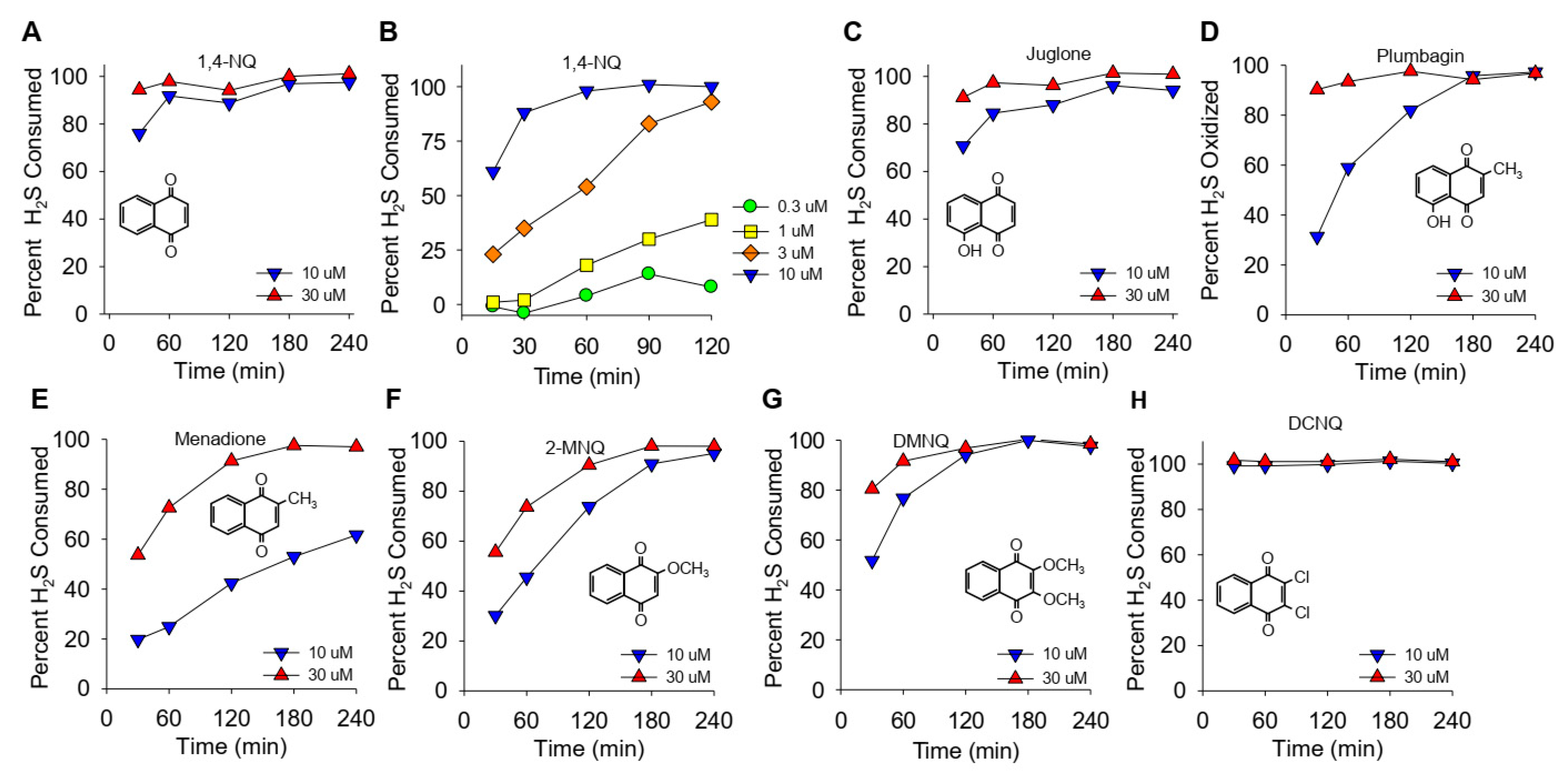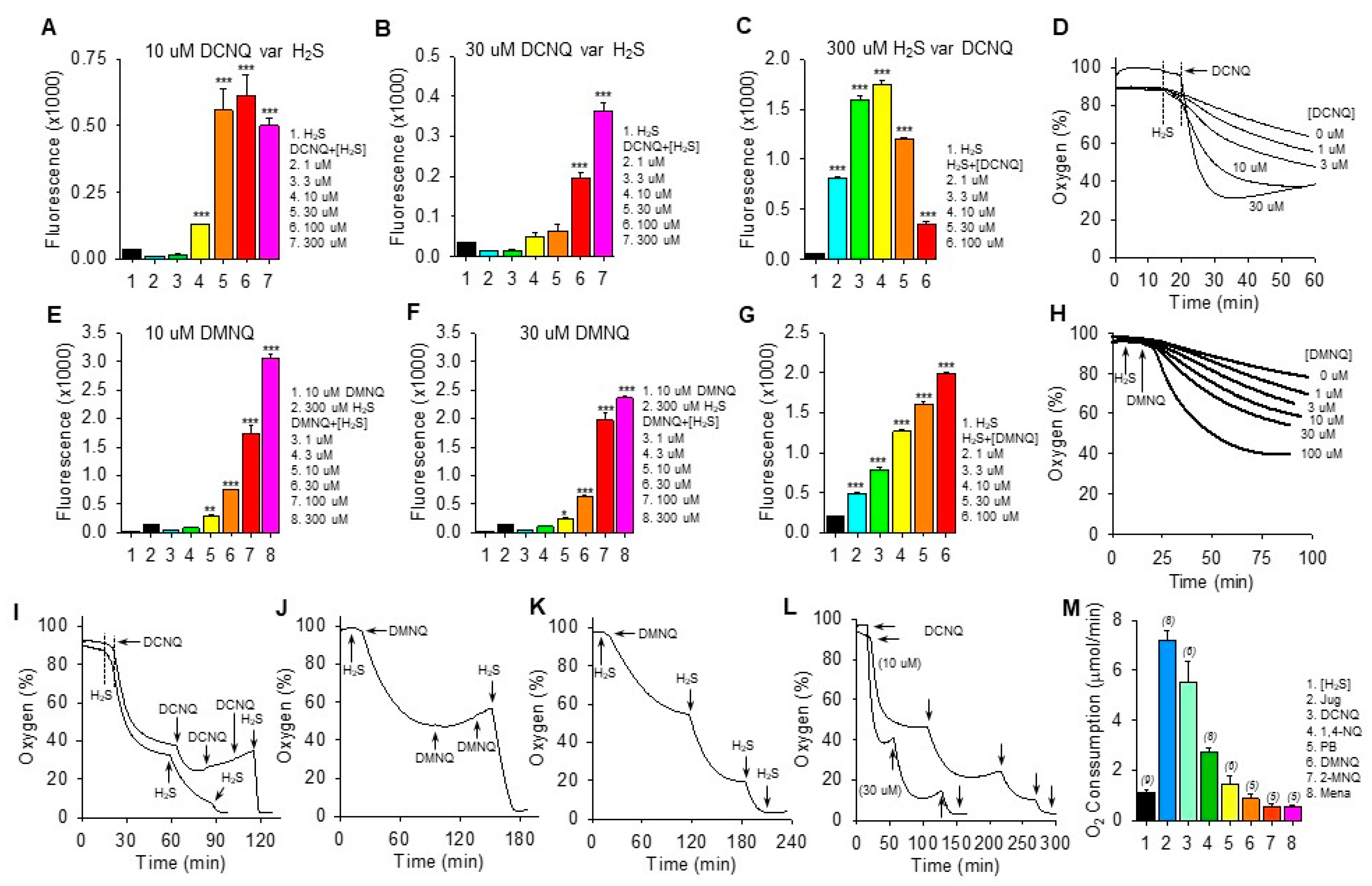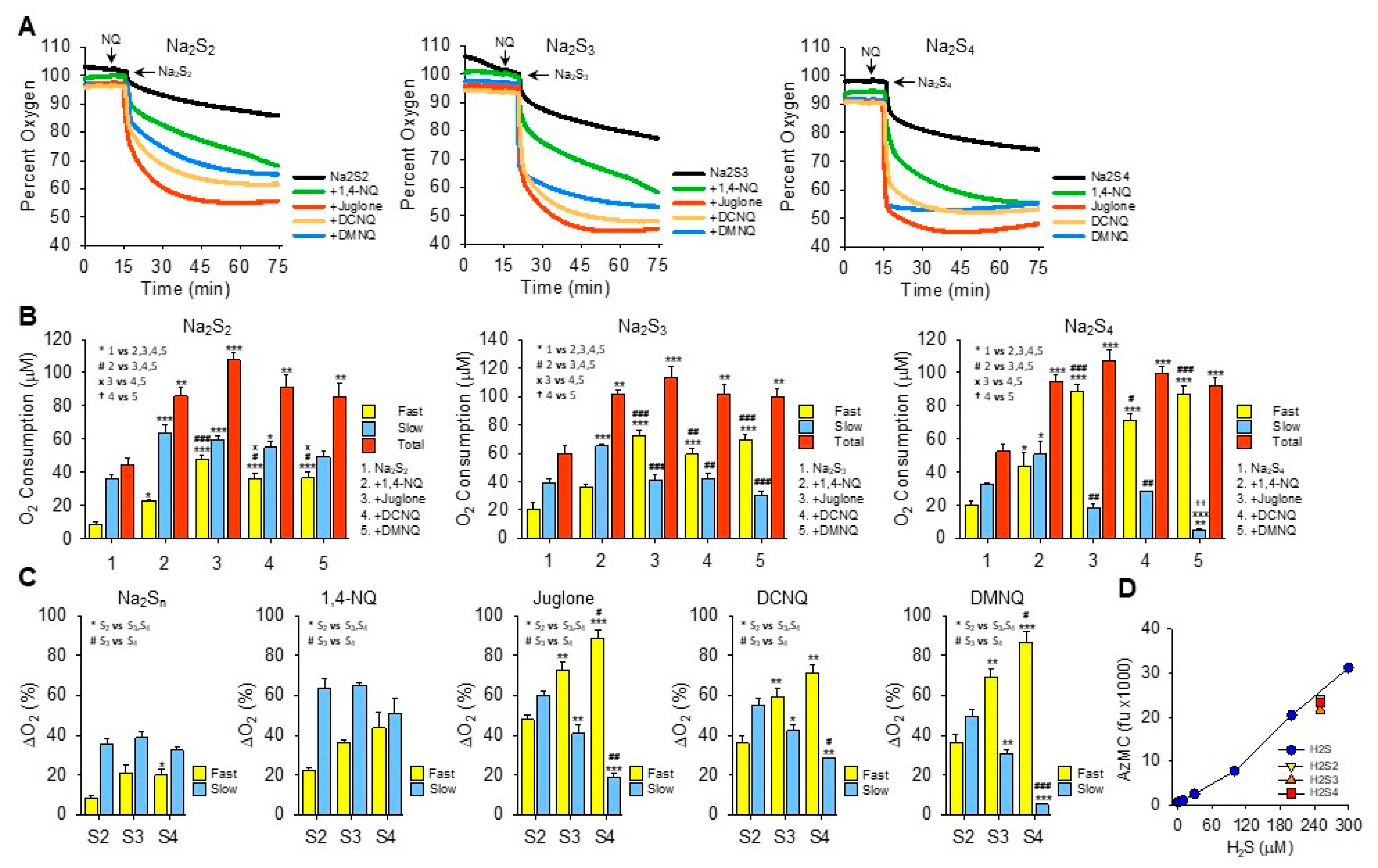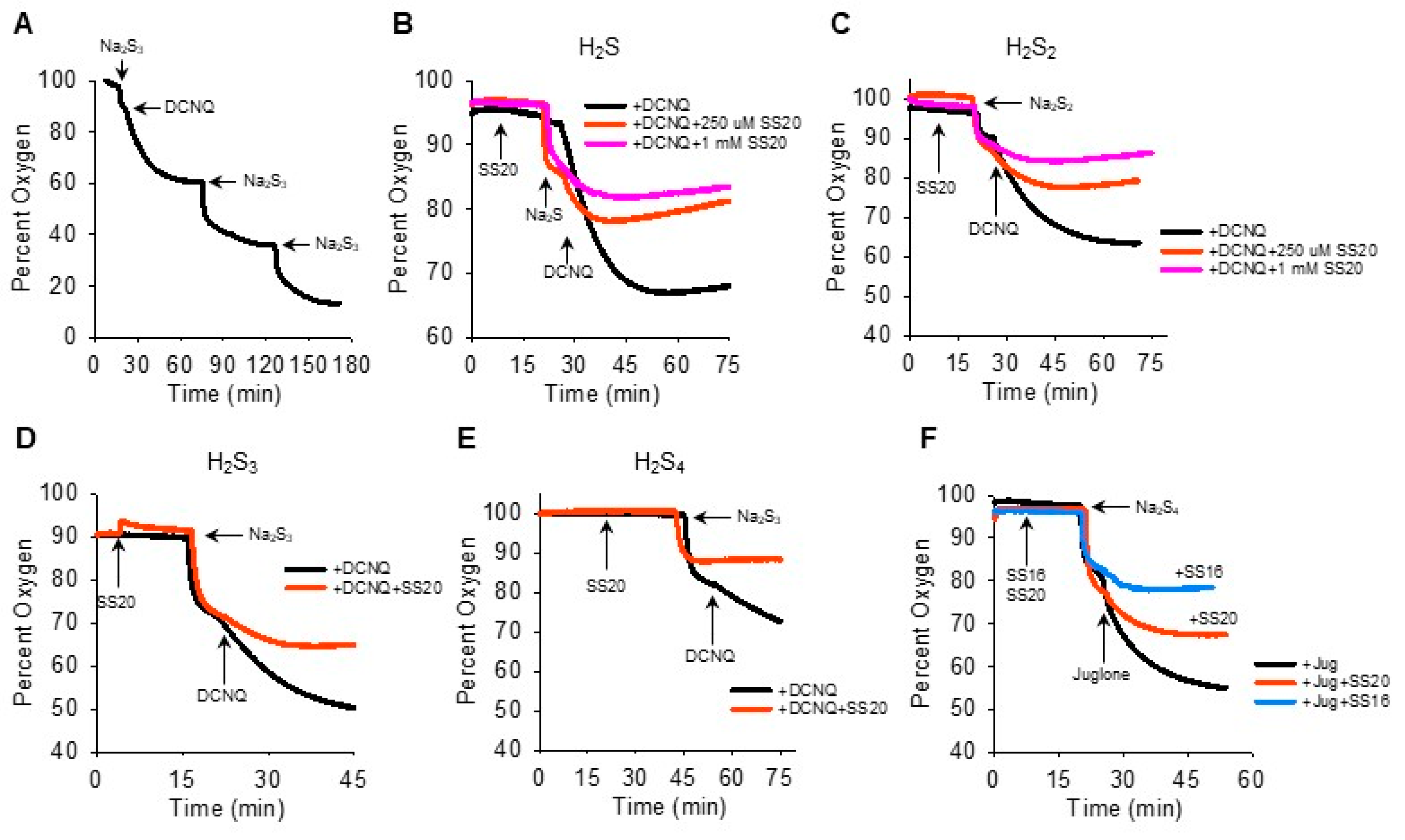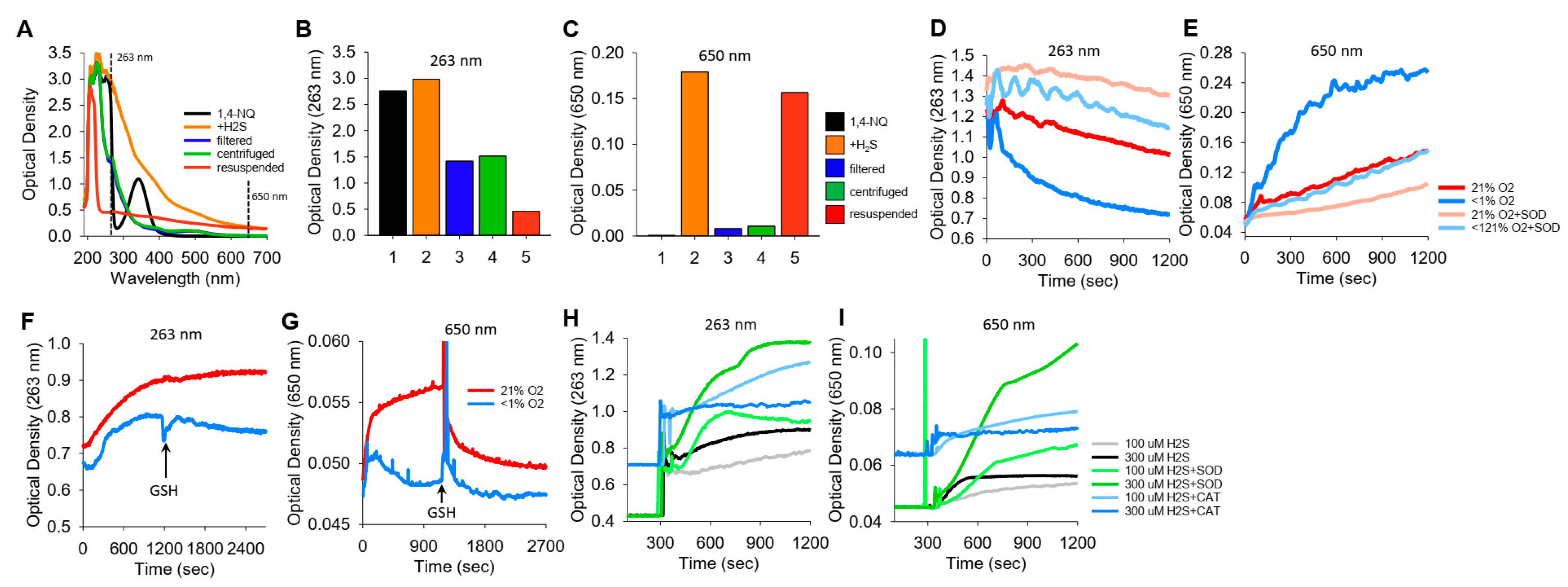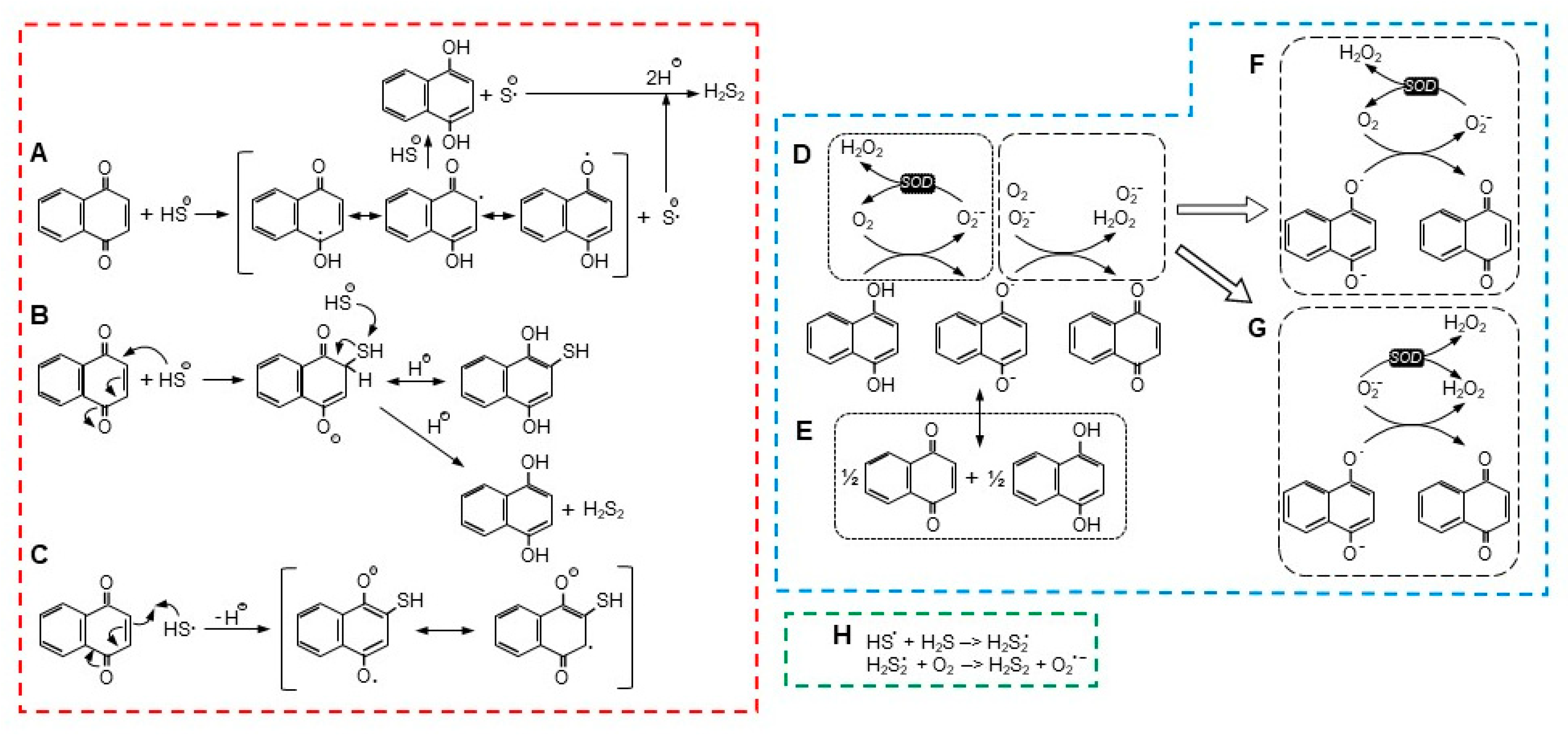3.1. Kinetics of NQ-Catalyzed H2S Metabolism
The effects of different NQs on the extent and rate of H
2S catabolism are shown in
Figure 1. Within the first 30 min, nearly 80% of the H
2S was removed by 10 μM 1,4-NQ, and it was essentially all cleared at 30 min by 30 μM 1,4-NQ (
Figure 1A). Lower concentrations of 1,4-NQ consumed progressively less H
2S (
Figure 1B), showing that the effect of 1,4-NQ on HS consumption was concentration dependent. Juglone, with a hydroxyl on the 5-carbon, was as effective as 1,4-NQ (
Figure 1C). Plumbagin, with a methyl in the quinoid carbon, was less efficacious than juglone (
Figure 1D), and H
2S consumption was further decreased with menadione, likely due to the loss of the 5-carbon hydroxyl (
Figure 1E). The rate and extent of H
2S removal then increased when the 2-carbon methyl group was replaced by the methoxy group in 2-methoxy-1,4-NQ (2-MNQ,
Figure 1F), and it further increased with the addition of a second methoxy group at the 3-carbon in 2,3-dimethoxy-1,4-NQ (DMNQ,
Figure 1G). Replacing the methoxy groups with chlorine in 2,3-dichloro-1,4-NQ (DCNQ,
Figure 1H) consumed H
2S faster than any of the other NQs. These results are similar to what we demonstrated for NQs with a single substitution on the quinoid group [
13] and extend our findings to the more substituted DMNQ and DCNQ. HMNQ (2-hydroxy-3-methoxy-NQ) did not consume H
2S, suggesting that the 2-hydroxy-3-methoxy-NQ has effects similar to the 2C hydroxyl in lawsone that does not react with H
2S [
13]. Our results also illustrate the utility of measuring H
2S consumption to provide a more comprehensive appreciation of H
2S metabolism by NQs.
3.2. Importance of C2 and C2 Quinoid Carbons in H2S Oxidation
As described in the introduction, there is uncertainty as to whether the initial H
2S oxidation occurs at the carbonyl group or at the quinoid carbon atoms. Both potentially reactive C2 and C3 quinoid carbons of DCNQ and DMNQ are occupied with chlorine or methoxy groups, respectively, yet they consume H
2S (
Figure 1). A number of experiments were conducted in an attempt to identify the importance of substituent groups at these carbons for H
2S oxidation. DMNQ was of particular interest as it does not form adducts with thiols such as GSH, yet it redox cycles as readily as menadione [
21].
We have previously shown that the amount of polysulfide production (measured by SSP4 fluorescence) and the rate of oxygen consumption by a variety of NQs with open positions on the C2 or C3 quinoid carbon are dependent on the concentrations of both NQ and H
2S [
12,
13]. Qualitatively similar results for polysulfide production (SSP4 fluorescence) were observed with DCNQ and DMNQ (
Figure 2). SSP4 fluorescence was concentration-dependently increased by H
2S when incubated with 10 μM or 30 μM DCNQ (
Figure 2A,B) or DMNQ (
Figure 2E,F), although production plateaued at 30 μM H
2S with 10 μM DCNQ. With 300 μM H
2S, DCNQ concentration-dependently increased SSP4 fluorescence up to 3–10 μM and appeared to decrease it thereafter (
Figure 2C), whereas with DMNQ, fluorescence continuously increased (
Figure 2G).
Both DCNQ (
Figure 2D) and DMNQ (
Figure 2H) concentration-dependently increased oxygen consumption when incubated with H
2S. Complete oxidation of 300 μM H
2S by DCNQ or DMNQ should consume all the ~200–265 μM oxygen in the chamber but clearly this was not the case for either NQ (
Figure 2D,H). To determine if this was due to depletion of H
2S or NQ, we measured oxygen consumption after sequential aliquots of either H
2S or NQ. As shown in
Figure 2I–K, oxygen consumption was not affected by additional DCNQ or DMNQ, whereas additions of H
2S consumed progressively more oxygen until all oxygen was consumed. However, the oxygen tension never fell much below 40% after the initial treatment, even with high concentrations of NQs. This is equivalent to a decrease of ~160 μM oxygen, approximately half the amount of H
2S that was added, suggesting that all the H
2S was consumed. This was further examined by incubating 10 μM and 30 μM DCNQ with 300 μM H
2S. As shown in
Figure 2L, oxygen consumed by either 10 μM or 30 μM DCNQ did not fall much below 40%, and it was clear that the initial bolus of H
2S was depleted prior to a second H
2S addition.
These experiments show that H
2S is the limiting factor, and they support our hypothesis that both DCNQ and DMNQ function as catalysts, as we have previously observed for other NQs [
12,
13]. The failure of the initial 300 μM H
2S to consume all the oxygen could be partially explained by continual oxygen diffusion into the reaction chamber. However, this is unlikely given the relatively slow rate of reoxygenation compared to the rapid rate of oxygen depletion observed with DCNQ. Assuming a small contribution from ambient oxygen diffusion into the chamber, our experiments are more consistent with an oxygen:H
2S consumption ratio of 1:2 in the initial reaction.
The rate of oxygen consumption was then used to measure the relative catalytic efficacy of different NQs, as this was the only parameter that could be measured in real-time. As shown in
Figure 2M, juglone had the highest rate of oxygen consumption, at 7.2 ± 0.38 μmol∙min
−1. The initial rate of oxygen consumption decreased in the following order: juglone > DCNQ > 1,4-NQ > plumbagin ~ DMNQ ~ 2-MNQ ~ menadione.
The low (≤30 μM) concentrations of NQs relative to H
2S in the above experiments clearly demonstrated the catalytic properties of NQs, but these were too low to allow an examination of possible direct effects of NQs on oxygen consumption in air-saturated buffer, where the oxygen concentration was close to 265 μM. To examine these reactions, the oxygen consumption was monitored while 100 μM of selected NQs was incubated with multiple aliquots of 100 μM H
2S. As shown in the traces of oxygen consumption (
Supplemental Figure S3), the effects of 1,4-NQ, juglone, plumbagin, and DMNQ were qualitatively similar, more oxygen was consumed by the first H
2S treatment, and progressively less oxygen was consumed by the third and fourth H
2S aliquots (summarized in
Supplemental Figure S3F). The decrease in oxygen consumption between the first and second H
2S was greatest for 1,4-NQ and juglone and progressively less for DMNQ and plumbagin. Conversely, half the amount of oxygen was consumed by the initial addition of H
2S to DCNQ compared to the subsequent three additions, which were all similar. The amount of oxygen consumed during the first H
2S treatment decreased in the order 1,4-NQ ~ juglone > plumbagin ~ DMNQ > DCNQ. Oxygen consumption by the second H
2S addition was similar for all NQs, and by the third H
2S addition, it was DCNQ > plumbagin > 1,4-NQ ~ DMNQ > juglone. By the fourth H
2S addition, it was DCNQ > plumbagin > DMNQ ~ juglone ~ 1,4-NQ.
The decrease in oxygen tension in all these reactions could not be fit to a one- or two-component exponential curve, so the rate of change in oxygen tension over the initial 2 min was evaluated as a linear decrease (summarized in
Supplemental Figure S3G). The rate of oxygen consumed after the first H
2S decreased in the following order: juglone > DCNQ ~ 1,4-NQ > plumbagin ~ DMNQ. The rate of oxygen consumption by the second addition of H
2S juglone decreased by 80% compared to the first, and the rates for 1,4-NQ and DMNQ also decreased by 58% and 43%, respectively. Conversely, the rate of oxygen consumption with plumbagin increased, while the rate for DCNQ remained near-constant. Adding H
2S to DCNQ produced an abrupt, linear decrease in oxygen tension that quickly leveled off. Clearly, DCNQ reacts differently to DMNQ and 1,4-NQ, which is most likely due to a nucleophilic replacement of the chlorines by -SH [
22,
23,
24].
If we assume that the simplest reaction would be 2H
2S + O
2 –> H
2S
2 + H
2O
2, then 50 μM of oxygen would be consumed by each addition of 100 μM H
2S, i.e., a 1:2 O
2:H
2S ratio. Any increase in this ratio would suggest the production of sulfoxides or other sulfur oxidation products (SOPs), and a decrease would suggest that oxygen is consumed independent of H
2S. As shown in
Supplemental Figure S3F, the O
2:H
2S ratio for both 1,4-NQ and juglone was close to 1.5:2, whereas it was nearly equal to 1:2 for plumbagin and DMNQ, but only 0.5:2 for DCNQ. This suggests that the first addition of H
2S to 1,4-NQ or juglone produced a substantial amount of SOP, whereas little SOP was initially produced by plumbagin or DMNQ. The 0.5:2 ratio for DCNQ suggests that half of the H
2S consumed does not require oxygen, and this ratio is more consistent with the formation of a DCNQ-S-DCNQ dimer, which is also very efficacious in oxidizing H
2S. With the second H
2S aliquot, the O
2:H
2S ratios were close to 1:2 for all NQs. By the third and fourth H
2S addition, the ratios for 1,4-NQ, juglone, and DMNQ were at or below 0.6:2, whereas those for plumbagin and DCNQ remained near 1:2. This suggests that less H
2S is oxidized after multiple additions to 1,4-NQ, juglone, and DMNQ and that it may be consumed in the formation of various NQ-S
n and NQ-S
n-NQ adducts or in anerobic reactions with other sulfur compounds, while there is little further adduct formation with plumbagin and DCNQ.
The oxygen consumption by 100 μM DCNQ and variable amounts of H
2S was then examined to further characterize this reaction. As shown in
Supplemental Figure S3H, increasing the H
2S concentration from 50 μM to 300 μM produced a concentration-dependent increase in oxygen consumption, and in each instance, the decrease in oxygen was rapid and abruptly stopped without any indication of an exponential decline. Oxygen was also steadily consumed by H
2S in the absence of DCNQ, and it was evident that towards the end of the experiment, more oxygen was consumed by 50 and 100 μM H
2S alone than by H
2S and DCNQ; similar results would likely have been observed at higher H
2S concentrations if the sample time was extended. The late rise in oxygen tension was due to oxygen diffusing back into the chamber at a rate of just under 1 μmol⋅min
−1. Collectively, these results suggest that H
2S from 50 to 300 μM was completely consumed after the addition to 100 μM DCNQ, but that an initial fraction of this H
2S did not result in oxygen consumption consistent with the formation of a DCNQ-S-DCNQ dimer or with nucleophilic replacement of chlorine by the sulfhydryl group from H
2S. The formation of NQ-S adducts is being addressed in ongoing studies.
If quinone is directly involved in H
2S oxidation, then we would not expect there to be a significant lag phase when the two are reacted, whereas, if another, intermediate species needs to be generated first (e.g., an NQ-S adduct), then a lag phase might be expected. To examine these possibilities, we measured the oxygen consumption for the initial 5–10 min after 300 μM H
2S was added to 10 μM NQ. There was little evidence of a lag phase for any NQ (
Supplemental Figure S3J–O).
3.3. Effects of GSH, Cys, and Propylamine Adducts on H2S Consumption by NQs
NQs with one or more unsubstituted quinoid C2 or C3 carbon may form adducts with GSH, Cys, or propylamine, which variously affect H
2S oxidation to polysulfides [
13]. A number of experiments were conducted to examine the effects of these adducts on H
2S consumption with special reference to the stability of the Cl and O-methoxy groups of DCNQ and DMNQ.
As shown in
Supplemental Figure S4, GSH had a minimal effect on H
2S consumption by 1,4-NQ, DMNQ, or DCNQ and slightly decreased H
2S consumption by juglone. Conversely, GSH greatly increased H
2S consumption by plumbagin and menadione and, to a lesser extent, by 2-MNQ. Cysteine decreased H
2S consumption by 1,4-NQ, juglone, and DCNQ, slightly increased oxygen consumption by menadione, and had no effect on H
2S consumption by plumbagin, 2-MNQ, or DMNQ. These results show that GSH has a minimal effect on H
2S consumption by an NQ with open C2 and C3 carbons, decreases it when there is a hydroxyl on the benzene carbon, and increases it when one of the quinoid carbons is occupied with either a methyl or methoxy group. Conversely, Cys has no effect or decreases H
2S consumption by all NQs except menadione. DMNQ with both C2 and C3 occupied with methoxy groups is refractory to both GSH and Cys, whereas Cys inhibits DCNQ, suggesting that Cl is a good leaving group, as discussed above.
Propylamine (PA) slowly forms adducts with NQs that have an unsubstituted C2 or C3 carbon, and this prevents further reactions of the NQs with GSH or Cys [
13]. In the present experiments, PA and NQs were incubated overnight to provide sufficient time for adduct formation. As shown in
Supplemental Figure S5A,B, 1,4-NQ-PA adducts consistently decreased H
2S consumption compared to 1,4-NQ alone, and the inhibitory effect of a 1:1 NQ:PA ratio became progressively less as the concentration of the diluted adduct increased from 3 μM to 30 μM, whereas the inhibitory effect of a 1:5 1,4-NQ-PA ratio was unaffected by the concentration of the diluted adduct. Propylamine also inhibited H
2S consumption by juglone (
Supplemental Figure S5C), whereas it had no or a minimal effect on H
2S consumption by menadione, plumbagin, or DMNQ (
Supplemental Figure S5D–F). Propylamine also inhibited oxygen consumption by H
2S and 1,4-NQ and by GSH and 1,4-NQ (
Supplemental Figure S5G,H). These results suggest that substitutions on the C2 and/or C3 quinoid carbons affect the ability of NQs to form adducts with PA, and this, in turn, decreases the ability of propylamine to impact H
2S oxidation. Collectively, the results also show that, as expected, H
2S oxidation by DMNQ is essentially unaffected by GSH, Cys, or propylamine.
3.7. Oxygen Consumption by NQ Reactions with Inorganic Hydropolysulfides
Abiko et al. [
14] reported that selected quinones including 9,10-phenanthraquinone, pyrroloquinoline quinone, vitamin K
3 (menadione), and coenzyme Q
10 (CoQ
10) redox cycle with oxygen to oxidize hydropersulfides (H
2S
2–4) but that they do not react with H
2S. This contrasts with our previous and current observations that menadione, CoQ
10, and a variety of other quinones and naphthoquinones oxidize H
2S to polysulfides [
12,
13,
29,
30,
31,
32]. We also found very little evidence in prior studies—using K
2S as a mixed polysulfide donor and detection with AzMC or SSP4—that these compounds oxidized polysufides. Here, we reexamined polysulfide metabolism by naphthoquinones using specific polysulfide salts—Na
2S
2, NaS
3, and Na
2S
4—and we monitored the oxygen consumption as a real-time index of the redox cycling process. The results of these studies are shown in
Figure 3 and summarized in
Table 1.
The addition of Na
2S
2, Na
2S
3, or Na
2S
4 to room-air-equilibrated PBS produced a rapid decrease in oxygen over the initial 2 min and then a slower decrease that did not reach equilibrium 60 min later (
Figure 3A). Approximately 2.5 times more oxygen was consumed during the fast component by Na
2S
3 and Na
2S
4 than by Na
2S
2, whereas there was no difference between them during the slow phase.
In general, all NQs increased the total oxygen consumption to approximately the same extent (~100 μmoles). However, the fraction consumed during the fast component increased as the number of sulfur atoms increased and the fraction of oxygen consumed by the slow component reciprocally decreased (
Figure 3B,C). The fast component of oxygen consumption with Na
2S
2 or Na
2S
3 was increased by NQs in the following order: juglone > DCNQ ~DMNQ > 1,4-NQ. With Na
2S
4, there was no difference between juglone, DCNQ, and DMNQ, and all were greater than 1,4-NQ. All NQs increased the slow component, and the slow component of oxygen consumption by 1,4-NQ with Na
2S
3 or Na
2S
4 was greater than the other NQs, presumably because 1,4-NQ’s fast component was lesser.
Oxygen consumption with juglone, DCNQ, or DMNQ reached a nadir before 75 min, whereas with 1,4-NQ, oxygen was continuously consumed, albeit at a slower rate, and in several instances (shown, for example, with Na
2S
2 and Na
2S
3), there appeared to be an additional component. In no instance did oxygen fall below ~45%, suggesting that one of the reactants, likely a sulfur species, was the limiting factor. This was similar to the result observed for H
2S (see
Section 3.2 and
Figure 2I–K), although the molar ratio of oxygen consumed to moles of H
2S
n added was around 1:2.5. When correcting for the moles of sulfur in the different polysulfides, the O
2:S ratios would be 1:5, 1:17, and 1:10 for Na
2S
2–4, respectively. Clearly, the amount of oxygen consumed was not dependent on the total sulfur but on some fraction that was relatively constant and independent of the total moles of sulfur. When using AzMC to estimate the amount of H
2S in the hydropersulfides, it appeared that there was ~250 μM of H
2S as a contaminant in all three hydropolysulfides (
Figure 3D). This suggests that the source of much, if not all, of the oxygen consumed in the NQ-S
2–4 reactions was the oxidation of H
2S. However, unlike hydropolysulfides, there was no fast oxygen consumption with H
2S alone or H
2S with NQs (cf.
Supplemental Figure S3J–O). This raises the possibility that hydropolysulfides specifically contribute to oxygen consumption through mechanisms in lieu of, or in addition to, direct redox cycling reactions, or that other factors, e.g., metal contaminants, are involved.
We then reversed the order of Na
2S
n-NQ addition to further examine the fast component of oxygen consumption and to determine if sulfur was the limiting factor. The addition of Na
2S
3 to the chamber produced the characteristic rapid decrease in oxygen, which was further decreased by DCNQ and by two subsequent additions of Na
2S
3 (
Figure 4A). This suggests that Na
2S
3 is the limiting factor, as is Na
2S (
Figure 2I). It was also evident that when 10 μM DCNQ was added after Na
2S
3, there was no rapid drop in oxygen and, instead, oxygen decreased exponentially, essentially in a pattern identical to that observed when 10 μM DCNQ was added to 300 μM H
2S (
Figure 2D). This raises the question, how much of the oxygen consumed in a DCNQ-Na
2S
n reaction is due to DCNQ reacting with H
2S, the latter being present as a contaminant or produced in an equilibrium reaction with H
2S
n? To answer this question, we measured the oxygen consumption by DCNQ and juglone with Na
2S
1–4 with or without the H
2S scavenging compounds SS20 and SS16 [
33,
34]. As shown in
Figure 4B,C, SS20 concentration-dependently inhibited oxygen consumption by Na
2S and Na
2S
2 reactions with DCNQ, and 250 μM SS20 inhibited reactions between DCNQ, Na
2S
3, and Na
2S
4. Both SS20 and SS16 inhibited oxygen consumption by Na
2S
4 and juglone. These results suggest that H
2S accounts for most, if not all, of the oxygen consumed in reactions between H
2S
2–4 and NQs.
3.8. LC-MS/MS Analysis of NQ Reactions with Inorganic Hydropolysulfides
We then identified the products formed in NQ-H
2S
n reactions with LC-MS/MS. Individual sulfur compounds (detected) produced by 20 min incubation of 100 μM Na
2S Na
2S
2, Na
2S
3, or Na
2S
4 (source) without or with 10 μM 1,4-NQ, 10 μM DCNQ, or 10 μM DMNQ in either 21% or <1% O
2 are shown in
Figure 5A.
Figure 5B shows the cumulative area under the curve for all sulfur species detected as a function of the sulfur species added (source). All Na
2S
n salts produced polysulfide species from S
1 to S
5 as well as sulfite (H
2SO
3) and thiosulfate (H
2S
2O
3) when dissolved, indicative of their general instability.
In general, without NQs, the relative AUC of the smallest sulfur-source and sulfur-detected species (Na2S1–2) was greater in a low (<1%) rather than a high (21%) oxygen buffer, whereas these differences became less pronounced as the number of S atoms in both the source and detected polysulfides increased. This suggests that smaller species are more prone to autoxidation. Sulfite and thiosulfate were more prevalent in 21% oxygen, suggesting some autoxidation of H2S1–4.
The H
2S AUC for all source Na
2S
1–4 incubated in 21% oxygen was decreased by 1,4-NQ and almost eliminated by DCNQ, but it was only minimally affected by DMNQ. As the Na
2S
1–4 samples were incubated with NQs for 20 min, these responses likely reflect the oxidation of H
2S, and the order of efficacy DCNQ > 1,4-NQ > DMNQ is consistent with that which can be observed for H
2S consumption in
Figure 1. A similar order was observed for samples incubated in <1% oxygen, albeit with less efficacy. H
2S
6 and H
2S
7 were not detected with H
2S as the source. These results show that H
2S is consumed by NQs irrespective of the source NaS
n, and that there is little evidence for net production of H
2S from polysulfides.
With Na2S as the source, and in 21% oxygen, DCNQ significantly decreased the formation of H2S2 and H2S3 but it did not affect H2S4 or H2S5, and 1,4-NQ and DMNQ did not affect H2S2–5. Conversely, in <1% oxygen, DCNQ increased H2S2–5, and 1,4-NQ increased H2S2,3. H2S6 and H2S7 were not detected in these samples. These results suggest that polysulfides are produced by NQ oxidation of H2S, but that in the presence of 21% oxygen, they are further oxidized to species other than polysulfides or sulfoxides.
In 21% oxygen, 1,4-NQ and DCNQ progressively decreased H2S2 and H2S3 formation irrespective of whether the source was Na2S2, Na2S3, or Na2S4, while DMNQ had no effect. The effects on H2S4 were less consistent. 1,4-NQ decreased H2S4 production from Na2S3 and Na2S4, whereas DCNQ decreased H2S4 production from Na2S2 and Na2S3. H2S5 production was increased by 1,4-NQ with Na2S2 and decreased by DCNQ with Na2S3 and Na2S4, while the production of H2S6 was generally similar to that of H2S5. In <1% oxygen, 1,4-NQ and DCNQ progressively decreased H2S2 and H2S3 production from Na2S2 and Na2S3, and DCNQ progressively decreased H2S4 production from Na2S4. The effects of 1,4-NQ and DCNQ on H2S4 production were variable, increasing production from Na2S2 and Na2S3 and decreasing it from Na2S4. This appeared to be a transition point, as both NQs increased H2S5 and H2S6 production from all three polysulfides.
Sulfite production from all Na2Sn was decreased by 1,4-NQ and DCNQ in 21% oxygen, along with that from Na2S and Na2S2 in <1% oxygen. Thiosulfate production was variously affected by NQs, Na2Sn, and oxygen tension with no consistent pattern.
We were able to detect two sulfenylated polysulfides, HS
4OH and HS
5OH, in these reactions (
Supplemental Figure S9). In general, approximately twice as much HS
4OH was produced compared to HS
5OH, twice as much sulfenylated polysulfide was produced in 21% oxygen compared to <1% oxygen, and the amounts of HS
4OH and HS
5OH formed were directly proportional to the number of sulfur atoms in the source Na
2S
1–4, irrespective of the absence or presence of an NQ or the specific NQ employed. DCNQ produced more sulfenylated polysulfides than any other NQ regardless of oxygen tension. This was followed by 1,4-NQ, while DMNQ was generally ineffective. The effects of different NQs on Na
2S
4 and Na
2S
5 formation were most noticeable when Na
2S was the source of sulfur. Sulfenylated species accounted for less than 10% of the total, and most were under 3%.
Collectively, these results suggest that in 21% oxygen, 1,4-NQ and, to a greater extent, DCNQ produce a net decrease in all sulfur species detected by LC-MS/MS irrespective of the degree of catenation of the initial (source) sulfur. The modest or nil effect of DMNQ is likely due to the generally slow reactivity of this NQ. The net consumption of sulfur compounds by 1,4-NQ and DCNQ is supported by comparing the sums of all AUCs for individual sulfur species (
Figure 5B). It is evident that there is a decrease in the AUC when samples are incubated with 1,4-NQ and DCNQ, especially when samples are incubated in 21% O
2. We hypothesize that among the undetected sulfur species is S
8, as is examined in the following section.
3.9. Formation of S8 Colloid by 1,4-NQ Oxidation of Na2S and the Effects of SOD and Catalase
We noticed in a number of reactions between NQs and H
2S that the solution became cloudy, which we interpreted as the result of colloidal sulfur (S
8) formation. These reactions were then examined in more detail by comparing the optical density at 263 nm (OD
263), purportedly the absorption maximum of soluble S
8 [
35], with the OD at 650 nm (OD
650), where S
8 does not absorb light but colloid formation will increase turbidity.
The spectra of 1,4-NQ before and after the addition of H
2S and the effects of filtering, centrifuging, and resuspending the precipitate are shown in
Figure 6A–C, where
Figure 6A shows the spectrum from 190 m to 700 nm and
Figure 6B,C show OD
263 and OD
650, respectively. 1,4-NQ, soluble S
8, colloid, and presumably other sulfur compounds contribute to OD
263. OD
263 is approximately halved by filtration of centrifugation, and some of the centrifuged colloid can be resuspended. OD
650 appears to be solely due to the colloid, as there is essentially no absorbance of light by 1,4-NQ or by the 1,4-NQ-H
2S reaction product after filtration or centrifugation, whereas much of the colloid can be recovered from the centrifuged pellet.
K
2S spontaneously oxidizes to form polysulfides. To examine if a colloid is also produced, we added K
2S to a buffer either equilibrated with room air (21% O
2) or sparged with N
2 for 20 min (<1% O
2), and we monitored OD
263 and OD
650 (
Figure 6D,E, respectively). OD
263 nm decreased relatively quickly (and exponentially) when K
2S was dissolved in <1% O
2, whereas when it was dissolved in 21% O
2, the decrease was slower and linear. The rate of decrease in OD
263 in <1% O
2 samples with SOD paralleled that of K
2S in 21% O
2 samples with or without SOD. Colloid formation (OD
650 nm) was considerably greater in <1% O
2 than in 21% O
2, and SOD inhibited colloid formation to the extent that OD was similar to that in 21% O
2. In 21% O
2, SOD produced a further decrease in OD
650 nm. These results validate the use of OD
650 as an index of colloid formation and demonstrate that this reaction is oxygen sensitive and inhibited by SOD. The rapid decrease in OD
263 nm and increase in OD
650 nm when there is low oxygen may reflect anerobic conversion of polysulfides to an S
8 colloid.
We then examined colloid formation in H
2S oxidation by 1,4-NQ. As shown in
Figure 6F,G, the incubation of Na
2S and 1,4-NQ produced both soluble and colloidal sulfur in 21% O
2, whereas there was less soluble sulfur and minimal colloid produced in <1% O
2. The addition of 1 mM GSH had minimal effects on soluble sulfur, but it rapidly depleted the colloid formed in 21% O
2. SOD increased soluble and colloidal sulfur production, whereas catalase was generally ineffective (
Figure 6H,I). These results support our hypothesis that some, if not all, of the unaccounted sulfur in the LC-MS/MS experiments (
Section 3.8) is colloidal sulfur. Our results also show that while oxygen is required for colloid formation in H
2S-NQ reactions, it paradoxically decreases the colloid spontaneously formed from polysulfides.
